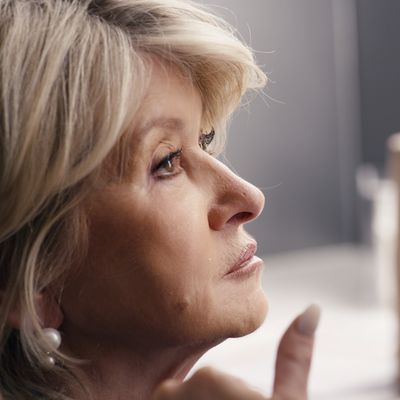
This week, Martha Stewart opens up in a juicy new Netflix movie directed by celebrity documentarian extraordinaire R.J. Cutler. For a woman who has been chatting and trussing chickens in front of a camera for upwards of 30 years, Stewart has been pretty guarded about the darker parts of her personal life. Based on an interview with the New York Times, she doesn’t seem entirely pleased with how she was portrayed in the documentary, which was promoted with a clip of her admitting to cheating on her husband of three decades, Andy Stewart. There are some true moments of vulnerability in Martha — she talks about the pain of Andy’s own infidelity and their subsequent divorce and how much she struggled as a young mother, and she revisits her infamous early-aughts insider-training scandal. Here’s what we learned.
She married Andy Stewart when she was 19 and got pregnant a few years later.
Stewart met her ex-husband through his sister, who was one of her classmates at Barnard. Andy was studying law at Yale, though he ultimately went into book publishing. “It was exciting to meet a sophisticated young man,” Stewart recalls in the documentary, adding that she clocked his American Express card and found him “intriguing, playful, and nice.” They got married in July 1961 — she was 19, he was 24.
Based on her own account, it was a difficult marriage with some warning signs as early as their five-month honeymoon in Europe. While staying in Florence, Stewart admits in the documentary, she kissed a stranger she met at the Duomo while Andy was back at the hotel. “It was neither naughty nor unfaithful,” she says of the kiss. “It was just emotional, of the moment. That’s how I looked at it. And it was exciting. I wish we could all experience such an evening.”
She struggled to adapt to her life as a young mother.
Stewart’s daughter, Alexis, was born a few years later in 1965. “Turns out it’s not natural at all to be a mother,” Stewart says in the film, describing her discomfort with having a child while she herself was so young. Her friend Kathy Tatlock observed that Stewart found it “hard to adapt to being a mom” and that she was often relieved when Alexis took a nap and she could be alone. “There was not a lot of affection in our house,” Stewart said of growing up. “How could I be a really great mother if I didn’t have the education to be a mother?”
She left a successful career on Wall Street after getting burned-out.
Before she launched the catering business that jump-started her career, Stewart worked in finance from 1968 to 1971. She was the only female stockbroker at her firm, and she says in Martha that “the stuff that went on in the back seat of taxis, I’m not even gonna talk about.” But she “learned a lot,” including “how to behave around billionaires.” She also made quite a bit of money herself — $250,000 a year, according to her former boss, Andy Monness. “I started to burn out because it was not an easy job,” she said. She quit when she and her husband bought a house in Connecticut, which ended up being the launchpad for her cooking and home-décor empire.
She and Andy had a long and unhappy marriage.
Stewart and her husband were said to have a rocky marriage that got worse as she became more successful. People once quoted Andy as saying in 1980 that his then-wife was “not tolerant of my negligence or my foolishness or my eccentricities.” One of the couple’s former friends told the same magazine in 1995 that Andy was “always being belittled or berated by her.” At some point, rumors of infidelity bubbled up, including in an unauthorized 1997 biography by Jerry Oppenheimer that claimed both of them had cheated.
Based on Stewart’s account, that seems to be true. “I don’t know how many different girlfriends he had, but I think there were quite a few,” she says in Martha. She also admits to what she describes as “a very brief affair with a very attractive Irishman” early on in their marriage, which she waves off as “nothing,” adding, “I would have never broken up a marriage for it. It was like the kiss in that cathedral.” (When the documentary producers tell Stewart on-camera that Andy claims he didn’t cheat on her until she told him about her own affair, she brushes it off. “Oh, well, that’s not true, I don’t think.”)
Eventually, Stewart says, Andy started a relationship with Robyn Fairclough, a flower designer who was working for her at the time and had moved into one of the barns on the Connecticut property. “It was like I put out a snack for Andy,” Stewart says of offering her employee a place to stay during some sort of apartment crisis. “Andy betrayed me right on our property. Not nice.” In a series of devastated letters she wrote to him about the affair, she said, “I am agonizingly jealous of your other women,” and described herself as “fragile” and “breakable.” “I’m so miserable, I cannot believe myself,” she wrote in another. “I should be vital, beautiful, sexual, and desirable … I’m worried and lonely, alone, hopeless.”
Soon after his affair with Fairclough, which made its way into the local rumor mill, Stewart says Andy asked for a divorce, which she still didn’t want. They separated in 1987 and divorced three years later. Eventually, Andy and Fairclough got married. They have since parted ways too, and he’s now married to a fellow publisher named Shyla.
She absolutely does not think she deserved to go to prison.
The documentary revisits the insider-trading scandal that landed Stewart in federal prison and derailed her career. In 2003, four years after she took her media company public and became the first self-made female billionaire in the U.S., Stewart was indicted on charges of obstruction of justice stemming from an interview she did with the FBI during a probe into her friend Samuel Waksal’s company, ImClone. She was ultimately found guilty by a jury and sentenced to five months in prison. “I had to go through that to be a trophy for these idiots in the U.S. Attorney’s office,” she says in Martha, arguing that the lead prosecutors — one of whom was an ambitious young James Comey — dragged her into the case because she was “the first billionaire woman in America.” She added, “Those prosecutors should have been put in a Cuisinart and turned on high.”
Although she often felt hopeless while incarcerated, she claims she ultimately found a way to be productive.
Stewart served her sentence at a federal prison in Alderson, West Virginia, that tabloids nicknamed Camp Cupcake for what was presumed to be a cushy stay for white-collar criminals. “It was not a cupcake,” Stewart says in Martha. On her sixth day, she claims, she was put in solitary confinement and denied food and water for a full day after accidentally brushing past an officer. “People were jumped, beaten,” she says. “I was warned, but I was not protected.”
In meticulous journal entries, Stewart talks about feeling hopeless and isolated during her sentence. “I am feeling a bit out of touch, a bit alone, a bit solitary,” one entry says. “I feel very inconsequential today, as if no one would miss me if I never came back to reality.”
She ended up making friends, a few of whom speak in the documentary, and giving business and gardening lessons to her fellow inmates. A journal entry from after her release says of her prison experience, “I had time for the very first time in many years to contemplate, to not worry, to get rid of the stress of three years. New friends, new ideas germinating. Ability through it all to be productive.”
Her longtime partner Charles Simonyi visited her only once while she was in prison.
After her divorce, Stewart dated Hungarian software developer Charles Simonyi from 1993 to 2008. Not much is known about their relationship, though Stewart often referred to him as her “boyfriend” and they were frequently seen at galas and benefits.
According to Martha, Simonyi visited Stewart only once in prison, which she says was “distressing to me.” “I don’t think he liked hanging out with someone in jail,” she reflects. “He was out on his boat, floating around the world.” Simonyi did, however, send his private jet to pick her up once she had finished her sentence, and they seem to have picked up their relationship from there, though Stewart acknowledges that her “life became a little less exciting,” which, in turn, “affected my relationship with Charles.”
In 2008, three years after Stewart was released from Alderson, Simonyi married Lisa Persdotter, a Swedish millionaire heiress 32 years younger than he. Stewart says Simonyi broke the news about his impending marriage during a trip to visit the president of Iceland, while they were in bed: “He said, ‘You know, Martha, I’m gonna get married to Lisa.’ I said, ‘Lisa who?’ He hadn’t told me a word.” She says Simonyi added, “And, by the way, her parents don’t want me to ever speak to you again.”
Stewart refers to her split from Simonyi as her “second divorce,” adding, “How can a man who spent 15 years with me just do that? What a stupid thing to do to someone that you actually care about.”
Her postprison comeback involved … Justin Bieber?
In the years after leaving prison, Stewart struggled to regain control of her career. By 2015, she was forced to sell her company, Martha Stewart Living, for less than a quarter of its worth. “My mojo was damaged,” she says in Martha, reflecting on losing over $1 billion in the sale.
But then Stewart reemerged somewhere unexpected: Comedy Central’s roast of Justin Bieber. The way Stewart and her publicist tell it in Martha, she accidentally rebranded herself there as a racy grandma who could weave her own wicker baskets but also hang with the boys, delivering zingers about her prison stint. (In fact, the comedian credited with writing her set is Tony Hinchcliffe, a longtime protégé of Joe Rogan and the guy who delivered an impressive number of racist jokes during a recent Trump rally at Madison Square Garden.)
Martha hails the Bieber roast as a victory for Stewart because it marked the beginning of her current pop-culture chapter. She shook off the misogynistic “ice queen” reputation that had plagued her for decades and found a way to make her aspirational domestic skill set — and her penchant for barbed commentary — a little more accessible via humor. The roast also helped cement her friendship with Snoop Dogg, who she says was sitting next to her smoking blunts during all seven hours of the production. Shortly afterward, Stewart and Snoop launched a cooking show together, where her appeal as a newly chilled-out goddess of domesticity was on full display.


